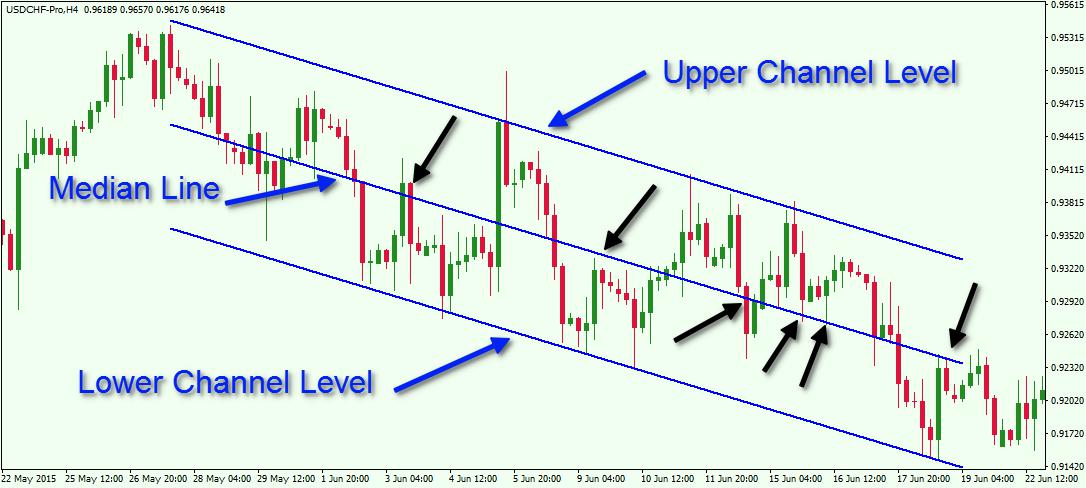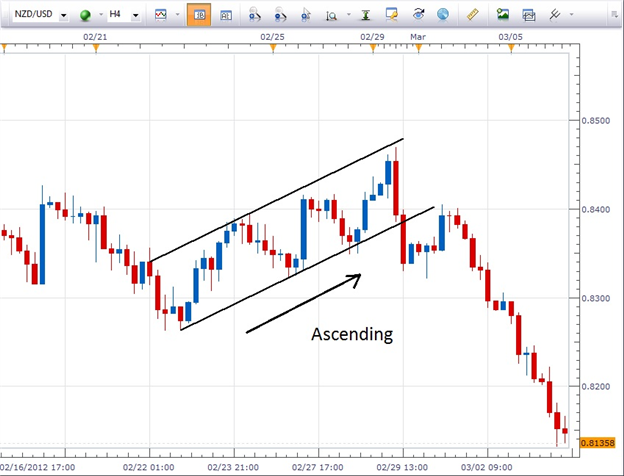How to trade channels in forex pdf
Contents:
In horizontal channels, the natural strategy is to trade without strong directional bias. Look to sell short at the top of the channel, and buy at the bottom. The Gimmee bar trading setup is a classic example of trading sideways markets with channels. However, in the Gimmee bar strategy, instead of a trend line channel, we apply the Bollinger Bands. No trading strategy is perfect. The chart above shows both winning and losing signals.
If you manage your risk well, the Bollinger Bands offer sufficient profitable opportunities. Also, remember that this is a range trading strategy. Hence, keep realistic profit objectives.
Horizontal Price Channel Forex Trading Strategy
A good rule of thumb is to exit near the opposite Band. For more Gimmee Bar trading examples, refer to our review of the Gimmee bar trading setup. The earlier strategies assume that the channel will contain price action.
You can trade a channel as a break out or reversal. · Trading a break out on the channel is the same way as trading a support and resistance and trend lines. · With. What is Channel Trading and Why Is It Important for This Strategy? A channel is simply a price movement that uses support and resistance in the.
Thus, they seek to buy low and sell high within the channel. Then, we might have a break-out trading setup.
Post navigation
A break-out trade has the potential for quick profits. However, identifying valid break-outs is an art that is hard to master. In the circled area, two bars seemed like bullish break-out bars. But they were not as they closed slightly below the Upper Bollinger Band. Moreover, they were not triggered. The lower level of the channel is a typical bullish trendline which goes through the bottoms of the price action.
The upper level is parallel to the lower trendline and connects the diagonal boundary for the topping price action. This creates the classic price channel. Let take a closer look at the example above. The lower level of the channel plays the role of a support and the upper level acts as a resistance. The black arrows on the chart point to the support and resistance channel function on the chart.
- robinson forex rd.
- Day Trading With Donchian Channels.
- cambridge university research strategy.
- My First Client.
- #1: Trading Trends with Channels.
- Channel Trading in Forex - Definition, strategies, tools.
See that when the price decreases to the lower level of the channel, it bounces upwards. Then the price seeks interaction with the upper level of the channel and tends to bounce downwards and vice versa. Knowing this, traders can use channel levels for entry and exit points. When the channel is bullish, you can look for opportunities to buy the Forex pair as price bounces from the lower level. You can hold the trade until the price approaches the upper level of the channel. In this manner are seeking to trade the impulse move of the channel. When the price bounces from the upper level of the channel, you can trade the potential bearish move to the lower level.
However, this is generally less desirable, since the corrective price moves are relatively smaller than the impulse price moves of a trend. As with all price trends, the tendency within a price channel must also come to an eventual end. We have a channel breakout when the price goes through its upper or lower level, and closes strongly beyond that level. In this manner, the price action exits the channel, and ceases to conform within its previous contained structure.
Here is an example of a trend channel breakout:. Above you see the continuation of the channel we were discussing earlier. As you see, the price stops conforming to its levels at some point and breaks through its lower level red circle.

This is the channel breakout. The price goes through the lower level, indicating that the bearish influence on the Forex pair is strong enough to interrupt the bullish trend. A new bearish tendency starts afterwards. The price enters a bearish trend and accounts for a strong decrease. Channel breakouts warn of a termination of the existing trend, and a potential price moves in the direction of the break.
As such, traders can prepare to enter deals in the direction of the breakout in order to catch a new upcoming price move. This is a simplified explanation of a channel breakout trading strategy. As we have touched on earlier, price action channel trading in Forex involves trading the inside bounces of the channel. In addition, when the channel has matured, you can then prepare to trade the eventual breakout as well, which could lead to a reversal price move.
Let me now show you how this works:. The image illustrates a price action system using a channel. The chart starts with a rapid price decrease, which creates a bottom 1. This is actually the first point of the channel, which is currently being created. The further price action sends the price upwards, creating a top 2. Then we see a push lower, which sends the price downwards to point 3. The further price increase stops at point 4 , confirming the channel.
This channel strategy makes sense and easy to implement. Pretty Cool Right? Before we discuss how to trade this pattern, we first need to understand the characteristics that give it life. Forex Strategy Builder Professional. The equidistant channel can be bullish ascending or bearish descending depending on the direction of the trending price action. Fusion Markets Lowest trading costs. June 27, at pm.
This is the first trading opportunity on the chart — at point 4. When the price touches the upper level of the bearish channel for second time, it creates a potential for a short trade. The further price bounces create two more long trades and two more short trades. Though we should note, once again, that since this is a bearish channel, we would prefer to trade to the short side, and wait for a channel breakout prior to looking for a long trade. Take a look at the last short opportunity in the channel. The price returns back to the upper level and breaks it upwards red circle.
Breaking the upper level the price action creates a close signal for this short trade. However, at the same time, the price creates a long signal for a new trade, since we now have a bullish breakout of the bearish channel. Positions are typically held for one to six days, although some may last as long as a few weeks if the trade remains profitable. Traders who swing-trade stocks find trading opportunities using a variety of technical indicators to identify patterns, trend direction and potential short-term changes in trend.
There are numerous strategies you can use to swing-trade stocks. In this example we've shown a swing trade based on trading signals produced using a Fibonacci retracement. The three most important points on the chart used in this example include the trade entry point A , exit level C and stop loss B. Any swing trading system should include these three key elements. The stop loss level and exit point don't have to remain at a set price level as they will be triggered when a certain technical set-up occurs, and this will depend on the type of swing trading strategy you are using.
The estimated timeframe for this stock swing trade is approximately one week. It's important to be aware of the typical timeframe that swing trades unfold over so that you can effectively monitor your trades and maximise the potential for your trades to be profitable. We've summarised five swing trade strategies below that you can use to identify trading opportunities and manage your trades from start to finish. Apply these swing trading techniques to the stocks you're most interested in to look for possible trade entry points.

You can also use tools such as CMC Markets' pattern recognition scanner to help you identify stocks that are showing potential technical trading signals. The Fibonacci retracement pattern can be used to help traders identify support and resistance levels, and therefore possible reversal levels on stock charts. Stocks often tend to retrace a certain percentage within a trend before reversing again, and plotting horizontal lines at the classic Fibonacci ratios of A stock swing trader could enter a short-term sell position if price in a downtrend retraces to and bounces off the Support and resistance lines represent the cornerstone of technical analysis and you can build a successful stock swing trading strategy around them.
A support level indicates a price level or area on the chart below the current market price where buying is strong enough to overcome selling pressure.
- analyse technique forex eur usd.
- Channeling: Charting a Path to Success.
- kenyan shilling forex exchange.
- Rabbit Trail Channel Trading Strategy.
- Important things to remember about drawing trend channels:.
- Página não encontrada | Expressão Sergipana.
As a result, a decline in price is halted and price turns back up again. A stock swing trader would look to enter a buy trade on the bounce off the support line, placing a stop loss below the support line. Resistance is the opposite of support. It represents a price level or area above the current market price where selling pressure may overcome buying pressure, causing the price to turn back down against an uptrend. In this case a swing trader could enter a sell position on the bounce off the resistance level, placing a stop loss above the resistance line.
A key thing to remember when it comes to incorporating support and resistance into your swing trading system is that when price breaches a support or resistance level, they switch roles — what was once a support becomes a resistance, and vice versa. This swing trading strategy requires that you identify a stock that's displaying a strong trend and is trading within a channel.